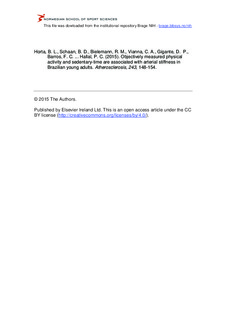Objectively measured physical activity and sedentary-time are associated with arterial stiffness in brazilian young adults
Horta, Bernardo L.; Schaan, Beatriz D.; Bielemann, Renata M.; Vianna, Carolina Avila; Gigante, D. Petrucci; Fernando, C.; Ekelund, Ulf; Hallal, Pedro C.
Journal article, Peer reviewed

View/
Date
2015-11Metadata
Show full item recordCollections
- Artikler / Articles [2119]
Original version
Atherosclerosis. 2015, 243,148–154. doi:10.1016/j.atherosclerosis.2015.09.005Abstract
Objective:
To examine the associations between objectively measured physical activity and sedentary time with pulse wave velocity (PWV) in Brazilian young adults.
Methods:
Cross-sectional analysis with participants of the 1982 Pelotas (Brazil) Birth Cohort who were followed-up from birth to 30 years of age. Overall physical activity (PA) assessed as the average acceleration (mg), time spent in moderate-to-vigorous physical activity (MVPA – min/day) and sedentary time (min/day) were calculated from acceleration data. Carotid-femoral PWV (m/s) was assessed using a portable ultrasound. Systolic and diastolic blood pressure (SBP/DBP), waist circumference (WC) and body mass index (BMI) were analyzed as possible mediators. Multiple linear regression and g-computation formula were used in the analyses.
Results:
Complete data were available for 1241 individuals. PWV was significantly lower in the two highest quartiles of overall PA (0.26 m/s) compared with the lowest quartile. Participants in the highest quartile of sedentary time had 0.39 m/s higher PWV (95%CI: 0.20; 0.57) than those in the lowest quartile. Individuals achieving ≥30 min/day in MVPA had lower PWV (β = −0.35; 95%CI: −0.56; −0.14). Mutually adjusted analyses between MVPA and sedentary time and PWV changed the coefficients, although results from sedentary time remained more consistent. WC captured 44% of the association between MVPA and PWV. DBP explained 46% of the association between acceleration and PWV.
Conclusions:
Physical activity was inversely related to PWV in young adults, whereas sedentary time was positively associated.
Such associations were only partially mediated by WC and DBP.
Description
Open Access funded by Wellcome Trust.
Under a Creative Commons license.